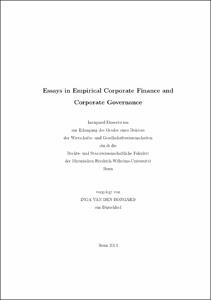Essays in Empirical Corporate Finance and Corporate Governance

Essays in Empirical Corporate Finance and Corporate Governance

| dc.contributor.advisor | Theissen, Erik | |
| dc.contributor.author | van den Bongard, Inga | |
| dc.date.accessioned | 2020-04-18T06:19:19Z | |
| dc.date.available | 2020-04-18T06:19:19Z | |
| dc.date.issued | 19.12.2013 | |
| dc.identifier.uri | https://hdl.handle.net/20.500.11811/5443 | |
| dc.description.abstract | Guided by the observation that ownership in large U.S. corporations is dispersed rather than concentrated in blocks of control (Berle and Means, 1932) and Jensen and Meckling's (1976) seminal principal-agent theory, much corporate governance research has put its focus on the conflict between managers and shareholders and the Anglo-American system of corporate governance. The present thesis provides several contributions to this literature in the substantially different context of the German corporate governance system. Chapter 1. Most existing theories of dividend policy imply that dividend announcements convey value-relevant information to market participants. However, in an efficient market, only the unexpected part of a dividend announcement should contain value-relevant information. The evaluation of the informational content conveyed by dividend announcements therefore crucially relies on the proper modeling of dividend expectations. We find that differences in modeling expectations have severe implications for the investigation of theories explaining the share price reaction to dividend announcements, including agency-based explanations. Chapter 2 provides novel contributions to the literature on dual-class share structures. Rather than focusing on a firm's decision to issue more than one share class, the chapter explores the drivers behind firms' decisions to abandon existing dual-class structures. We exploit a change in the index selection rules of Deutsche Boerse that discriminated against dual-class companies by adversely affecting their relative weight within selection indices. We suggest and empirically support the hypothesis that the change in rules resulted in a trade-off for large controlling shareholders between safeguarding their extant private benefits of control and the costs associated with a loss in index weight. Aside from the concentration of control, the two-tier board structure is another distinctive feature of Germany's corporate governance system. As the name suggests, German corporations are governed by two separate boards: an executive board managing the firm and a supervisory board overseeing management. Frequently, members of the board do not only serve on their own board, but are also simultaneously active in several other outside boards. The literature on busy boards suggests that such additional commitments may put too much strain on the board's resources and thereby adversely affect the compliance with its monitoring duties. Chapter 3 employs methods from social network analysis to explore aspects of board busyness and revisits the relationship between firm governance and the board's position in the network of directors. | en |
| dc.language.iso | eng | |
| dc.rights | In Copyright | |
| dc.rights.uri | http://rightsstatements.org/vocab/InC/1.0/ | |
| dc.subject | Corporate Governance | |
| dc.subject | Dividendenankündigungen | |
| dc.subject | Eigentümerstruktur | |
| dc.subject | Vorzugsaktien | |
| dc.subject | Direktorennetzwerk | |
| dc.subject | Dividend Announcements | |
| dc.subject | Ownership Structure | |
| dc.subject | Dual-Class Shares | |
| dc.subject | Director Network | |
| dc.subject.ddc | 330 Wirtschaft | |
| dc.title | Essays in Empirical Corporate Finance and Corporate Governance | |
| dc.type | Dissertation oder Habilitation | |
| dc.publisher.name | Universitäts- und Landesbibliothek Bonn | |
| dc.publisher.location | Bonn | |
| dc.rights.accessRights | openAccess | |
| dc.identifier.urn | https://nbn-resolving.org/urn:nbn:de:hbz:5-34562 | |
| ulbbn.pubtype | Erstveröffentlichung | |
| ulbbnediss.affiliation.name | Rheinische Friedrich-Wilhelms-Universität Bonn | |
| ulbbnediss.affiliation.location | Bonn | |
| ulbbnediss.thesis.level | Dissertation | |
| ulbbnediss.dissID | 3456 | |
| ulbbnediss.date.accepted | 17.12.2013 | |
| ulbbnediss.fakultaet | Rechts- und Staatswissenschaftliche Fakultät | |
| dc.contributor.coReferee | Haselmann, Rainer |
Dateien zu dieser Ressource
Das Dokument erscheint in:
-
E-Dissertationen (288)




